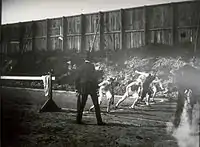Fred Bonine
Frederick N. Bonine (October 21, 1863 – August 22, 1941) was an American sprinter and eye doctor. He held the world's record in the 110-yard dash for 35 years from 1886 until 1921. He later became an internationally known eye doctor who saw over one million patients at his office in Niles, Michigan.
Fred Bonine | |
|---|---|
 | |
| Born | October 21, 1863 |
| Died | August 22, 1941 (aged 77) |
| Alma mater | University of Michigan |
| Known for | Held world's record in 110-yard dash from 1886 to 1921 |
Early years and athlete
Bonine was born in Niles, Michigan in 1863. His father, Evan J. Bonine, was a physician with a practice in Niles. Evan J. Had been a civil war surgeon, a diary in the Niles museum recounts his travel south by stagecoach and his history of performing many amputations. Fred N. Bonine attended the Niles public schools, he then enrolled at the University of Michigan where he received his MD degree. He received advanced training in ear eye nose surgery in Frieberg, Germany. At Michigan he was a member of the football and track teams.[1] In 1886, Bonine set a world's record with a time of 10.8 seconds in the 110-yard dash. The record stood for 35 years until it was broken in 1921 by Charley Paddock.[1][2] That same year, Bonine was the captain of the Michigan track team that became the first athletic team from the west to compete in New York.[1]
Medical practice

Bonine later became a nationally known eye doctor. Each year, tens of thousands of patients from around the world reportedly sought treatment at Bonine's office above a corner drug store in Niles, Michigan.[1][3] Bonine regularly treated as many as 517 patients in one day and regularly saw 200 patients in a day. Hundreds lined up each day, none with appointments, to see him, with each being charged the same fee of two dollars for a first visit and one dollar for subsequent visits. Special buses from Chicago to Niles ran twice a week to bring patients to see Bonine.[4] Several restaurants, gift shops, and hotels in Niles reportedly "owed their existence to the patronage drawn to this small city by his fame."[5] One newspaper wrote:
"So numerous were the patients who filled his office each day, that brutally long hours were required to care for them. He never spared himself, frequently remaining until 10 o'clock or even midnight to finish. An indefatigable worker, he had the assistance of only a small office force. One of his main therapies was a treatment nonsurgically for dissolving cataracts with a proprietary solution. It was said of him that he rivalled Napoleon Bonaparte and Thomas A. Edison for going without sleep. . . . A time-worn, old-fashioned suite of office in Niles was a crossroads for that vast army of unfortunates with afflicted eyesight who came from the four corners of the earth seeking the professional assistance of Dr. Fred N. Bonine."[5]
He was reported to have seen 1,500,000 patients in nearly 50 years of practice.[4]
Sports medicine and boxing commissioner
In 1912, he served as a medical advisor to the United States team at the 1912 Summer Olympics in Stockholm, Sweden. Bonine was also a member of the Michigan State Athletic Board of Control and the Michigan Boxing Commission.[2][4] He became a close friend of heavyweight boxing champion Jack Dempsey after reportedly saving Dempsey's eyesight at the height of the boxer's career.[4] In 1925, at Bonine's office in Niles, Michigan, Dempsey and African-American champion Harry Wills signed papers agreeing to fight for the heavyweight championship of the world.[6][7] (The fight never took place.[4])
Community service and later years
Bonine also served nine years as the mayor of Niles, Michigan. He was married to Viva Thomas and a member of the Trinity Episcopal Church in Niles.[4] He was a 33rd degree Mason and was honored at a Masonic dinner in November 1934 on the occasion of his 50th year in the Masons.[8]
Bonine became ill with pneumonia in the spring of 1938. He suffered a stroke in June 1938 from which he recovered in part, but he was unable to return to his medical practice.[5] Bonine died at his home in Niles in August 1941 at age 77.[2][9] Stores and factories in Niles closed for Bonine's funeral, which was held at the Trinity Episcopal Church.[10]
References
- "Nothing Bad About Being a Country Doctor, Says Bonine". The Evening Independent (AP story). October 17, 1925.
- "Fred Bonine, Noted Sportsman, Is Dead". The Telegraph-Herald, Dubuque, Iowa (AP story). August 24, 1941.
- "Kind "Dr. Fred" Awaits 50,000 More Patients: That Number of Clients Annually Crowds to Visit World Famous Specialist of Niles, Michigan". The Hartford Courant. January 23, 1938.
- "Dr. Bonine, Served 1,500,000 Patients: Niles, Mich., Eye Specialist, Who Had Treated 500 in a Single Day, Dies at 77; Star Runner In Youth; Held 100-Meter Dash Record 36 Years -- Ex-Mayor Also Had Been an Alderman". The New York Times. August 24, 1941.
- "Dr. Fred N. Bonine Dies In Niles: Noted Eye Specialist Was Stricken In 1938; Rites Monday At 2:30; End Comes One Minute Before Midnight For South End City's Most Distinguished Citizen; Ministered To Thousands". The News-Palladium, Benton Harbor, Michigan. August 23, 1941. p. 1.
- "Dempsey-Wills Sign to Fight in Indiana: Go Across Border to Affix Their Names and $350,000, a Record Forfeit, Is Posted". The New York Times. September 30, 1925.
- "Dempsey to Battle Negro at Michigan City, Ind., Next September". The Reading Eagle (AP story). September 30, 1925.
- "Michigan Mason Honor Dr. Fred N. Bonine at Niles". The News-Palladium. Benton Harbor, MI. November 24, 1934.
- "Was Noted Track Star". Lawrence Journal-World (AP story). August 23, 1941.
- "11,000 Pay Tribute at Dr. Bonine Rites: Stores and Factories Closed in Honor of Niles, Mich., Specialist". The New York Times. August 26, 1941.